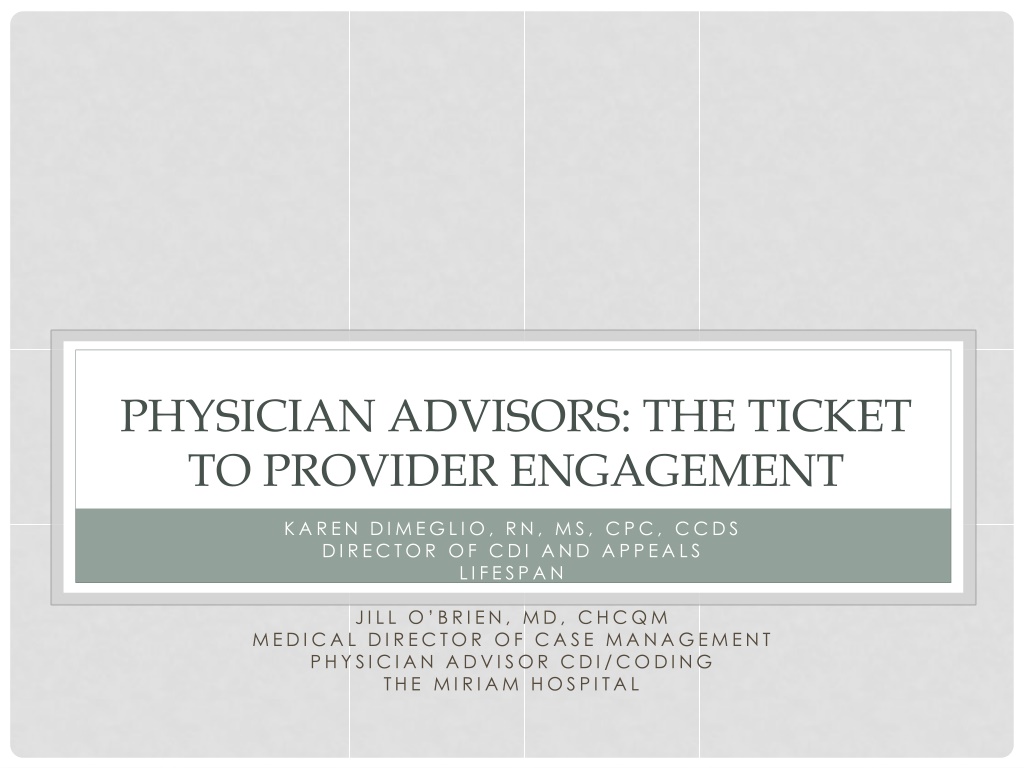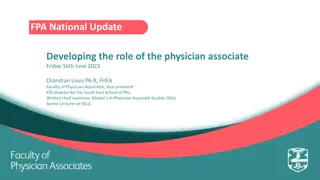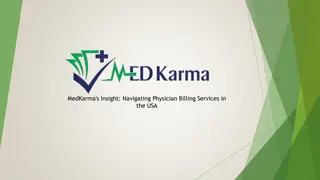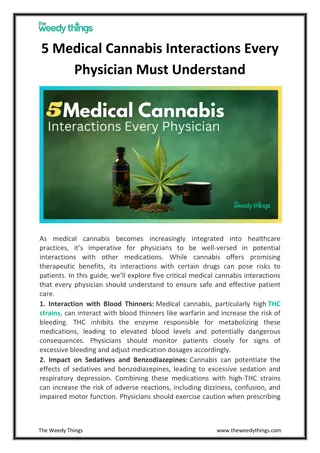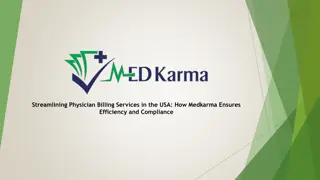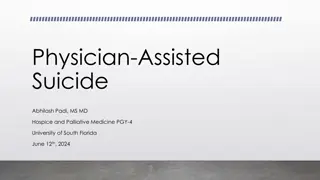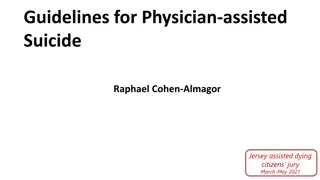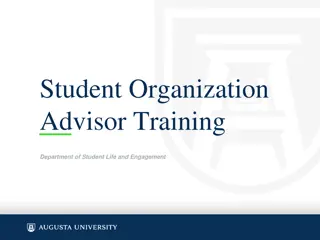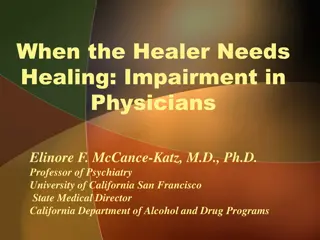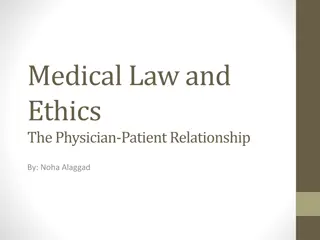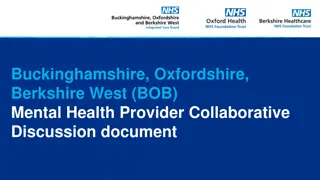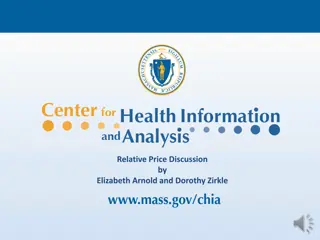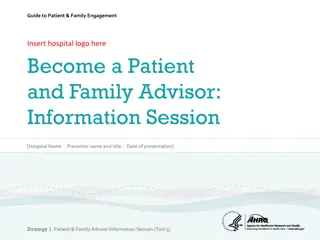Physician Advisors: Enhancing Provider Engagement Strategies
Explore the pivotal role of Physician Advisors in improving provider engagement through optimal strategies, essential qualities, and dispelling common myths. Learn how to identify the right Advisor and establish actionable areas for enhanced engagement.
- Physician Advisors
- Provider Engagement
- Clinical Documentation
- Healthcare Strategies
- Physician Relationships
Download Presentation

Please find below an Image/Link to download the presentation.
The content on the website is provided AS IS for your information and personal use only. It may not be sold, licensed, or shared on other websites without obtaining consent from the author. Download presentation by click this link. If you encounter any issues during the download, it is possible that the publisher has removed the file from their server.
E N D
Presentation Transcript
PHYSICIAN ADVISORS: THE TICKET TO PROVIDER ENGAGEMENT KA REN DI MEGLI O, RN, MS, CPC, CCDS DI RECTOR OF CDI A ND A PPEA LS LI FESPA N JI LL O BRI EN, MD, CHCQM MEDI CA L DI RECTOR OF CA SE MA NA GEMENT PHY SI CI AN A DVI SOR CDI /CODI NG THE MI RI AM HOSPI TA L
LEARNING OBJECTIVES At the completion of this educational activity, the learner will be able to: Identify the optimal strategies to engage LIPs in Clinical Documentation Best Practices Describe the Fundamental Role of Physician Advisors to Clinical Documentation Integrity programs Demonstrate how to identify the right Physician Advisor for your program Establish actionable areas for Physician Advisor involvement to improve provider engagement.
KEYS TO PROVIDER ENGAGEMENT Speak their language Reputation How do I compare? SHOW ME THE DATA! Answer the WHY? You scratch my back, I ll scratch yours Speak from experience Learn best from a practicing provider
WHO HOLDS THE KEYS? BRING IN THE PHYSICIAN ADVISOR
PHYSICIAN ADVISOR MODELS Model Type of Facility Full-time Physician Advisor Large Multi-hospital Centers Part-time clinical and Part-time Physician Advisor Single Hospital Full-time clinical with additional PA responsibilities Single Hospital Get what you can get No Physician Advisor Not Recommended
ESSENTIAL QUALITIES OF A PHYSICIAN ADVISOR Well-respected active provider Several years experience within hospital community* Good relationships with various service line providers Excellent communication skills Teacher Advocate Mediator Strong sense of empathy Continuous learner Ever-changing economic landscape
DISPEL SOME MYTHS You need a PA right away, so just appoint someone Pick the best documenter You don t need one person; just find a bunch of specialists that can support your efforts The CMO or med staff president can fill this role After all, you just want MDs to answer their queries
THE PHYSICIAN ADVISORS MANY STAKEHOLDERS Medical staff Make it easier to get it right Respond to staff concerns Educate as needed CDI and coding professionals Provide clinical guidance Support initiatives Hospital Quality reporting An eye on the bottom line
AREAS OF PHYSICIAN ADVISOR ACTION Provider education Lecture-based, data-driven, literature-supported CDI emails/pocket guides 1 on 1 Query support Query as an education tool Getting to WHY a provider is not responding Adjusting template/wording to improve response rate Leveraging CDI initiatives Mortality review committee Systemwide definitions Escalation policy
ANGER This is a game to make the hospital money!
WHAT IS CLINICAL DOCUMENTATION? What we write in our notes Acts as a communication tool to staff, other providers Should accurately express a patient s: Severity of illness Risk of mortality Length of stay Utilization of resources
WHAT IS CODING? Coders review your notes and then translate those diagnoses to ICD-10 codes ICD codes are tracked and monitored Each code has: An expected length of stay An expected mortality An associated monetary compensation
UNFORTUNATELY What we write in our notes is not always what coders translate to ICD-10 codes. AND We need to learn the coders language, because they cannot infer from ours.
WHY DO WE CARE SO MUCH? Data is being collected (and at times publicly reported) LOS Mortality Utilization of resources More accurate documentation will keep you from being an outlier
MORTALITY REVIEW COMMITTEE Explained Vizient data acquisition Multidisciplinary team composed of med staff, RN leadership, CDI director, and data analysts Exposed how improper documentation affects mortality data Shifted culture
BACKGROUND Started 2012 Multidisciplinary Team RN leadership Surgery with subspecialties Hospital Medicine Emergency Medicine Radiology ICU Cardiology Quality Clinical Documentation Initially reviewed Vizient outlier cases (low expected mortality) CDI analysis- MD advisor to CDI. Improved documentation Improved recognition of cases for MRC discussion
MISSION Understand our Vizient Data Streamline documentation and coding processes to ensure data is accurately reflective of Mortality Create culture of safety and accountability for all hospital deaths Address hospital system issues across service lines, levels of care, and professions.
Understanding and Improving Inpatient Mortality in Academic Medical Centers Raj Behal, MD, MPH, and Jeannine Finn, RN, MBA Acad Med. 2009; 84:1657 1662. To move the needle, you need to fix the documentation and the culture.
VIZIENT Create basis for comparing healthcare outcomes amongst institutions Analyzed data from 115 institutions in AMC (academic medical center) administrative data Identified presenting DRGs and their observed mortality Performed linear regression to identify statistically significant variables that led to increased mortality Tested the model with another cohort from same AMC admin data More broadly tested against larger cohort from other institutions 2013 UHC Risk Adjustment Methodology.
MORTALITY DATA Expressed as a percentage of deaths observed over those expected More accurate documentation reflects the TRUE expected mortality, thus reducing the ratio of observed deaths/expected deaths
EXAMPLE 89 year old male with h/o metastatic prostate cancer on Lupron presents to ED with fever and chills found to have WBC 22, lactate 4.0, Cr 3.2, plts 90, and +UA. BP on presentation 80/60, after fluid resuscitation 72/48. Line placed, antibiotics and pressors begun. Transferred to ICU.
IF YOU DOCUMENT A/P A/P Septic shock d/t UTI Metastatic prostate cancer Thrombocytopenia AKI Protein-calorie malnutrition Urosepsis abx Low BP, begin pressors Low plts monitor Dehydration Cachexia, consult nutrition Expected mortality rate 61% Expected mortality rate 4.5%
DENIAL I m not the problem they are!
MORE OPTIMAL DOCUMENTATION Impression Severe sepsis Probable R knee septic arthritis d/t hardware infection Acute toxic/metabolic encephalopathy d/t medications/sepsis Acute kidney injury (AKI)
BARGAINING Well, fine, but you have to ...
RESPOND TO MEDICAL STAFF CONCERNS Timing of CDI pages Bedside procedure notes Query format Problem diagnoses Demand NSTEMI Sepsis Acute encephalopathy
THE RESULTS Stark reduction in number of queries for inadequate documentation of bedside procedures Steep decline in number of unanswered queries (>24hours old) From over 50 per week down to 20
DEPRESSION This is all too hard to learn!
TOP 10 VARIABLES THAT AFFECT MORTALITY Ask yourself: Does my patient have any of these? Fluid electrolyte abnormalities Renal failure (CKD stage, ATN, CKD d/t DM or HTN) Coagulopathy (including thrombocytopenia) Malnutrition/obesity Respiratory failure Shock with type Encephalopathy CHF with type and acuity PVD (aneurysms, arthrosclerosis) Liver disease (type and associated complications)
ACCEPTANCE I get it now.
RESOURCES FOR PHYSICIAN ADVISORS Society of Hospital Medicine (SHM) Association of Clinical Documentation Improvement Specialists (ACDIS), The Physician s Guide to Clinical Documentation Improvement American College of Physician Advisors www.acpadvisors.org
QUESTIONS/CONCERNS? JOBRIEN8@LIFESPAN.ORG
